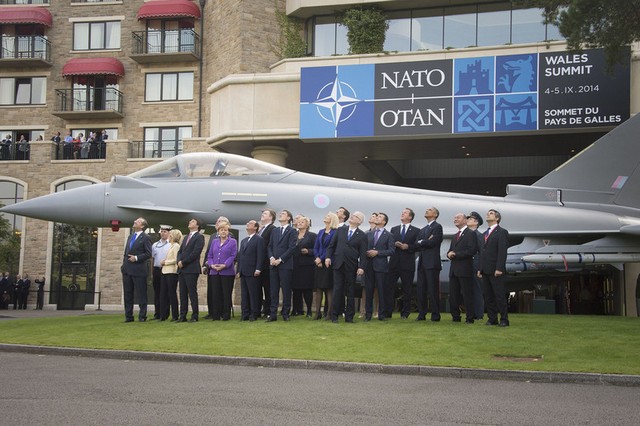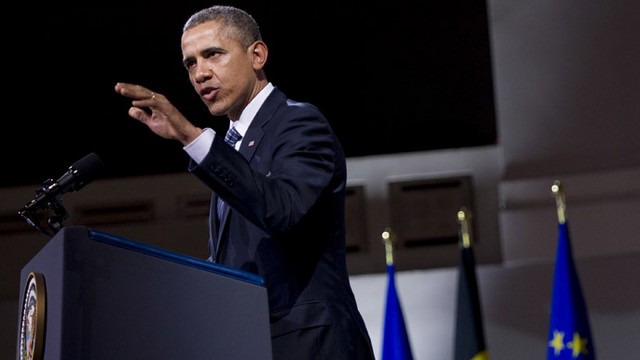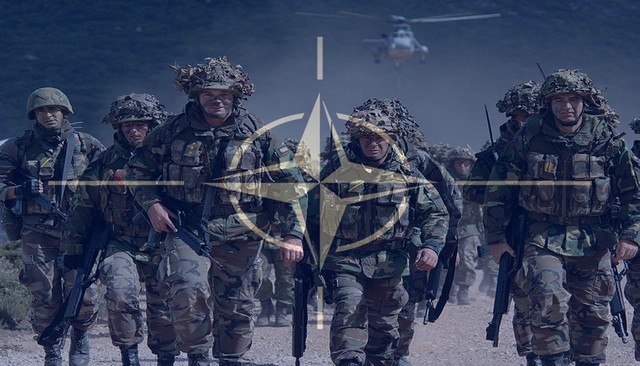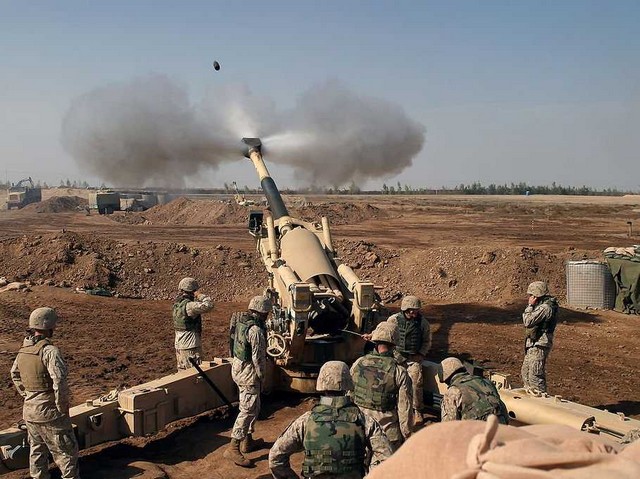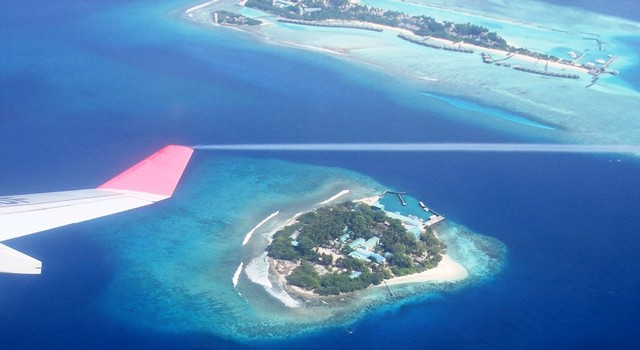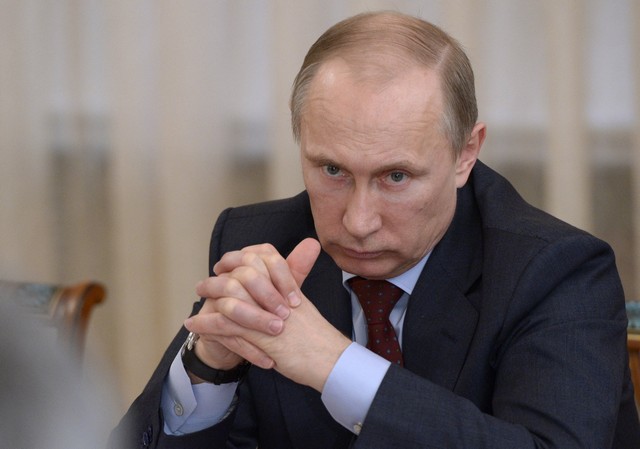By Tom Engelhardt
Their Videos and Ours, Their “Caliphate” and Ours
Whatever your politics, you’re not likely to feel great about America right now. After all, there’s Ferguson (the whole world was watching!), an increasingly unpopular president, a Congress whose approval ratings make the president look like a rock star, rising poverty, weakening wages, and a growing inequality gap just to start what could be a long list. Abroad, from Libya and Ukraine to Iraq and the South China Sea, nothing has been coming up roses for the U.S. Polls reflect a general American gloom, with 71% of the public claiming the country is “on the wrong track.” We have the look of a superpower down on our luck.
What Americans have needed is a little pick-me-up to make us feel better, to make us, in fact, feel distinctly good. Certainly, what official Washington has needed in tough times is a bona fide enemy so darn evil, so brutal, so barbaric, so inhuman that, by contrast, we might know just how exceptional, how truly necessary to this planet we really are.
In the nick of time, riding to the rescue comes something new under the sun: the Islamic State of Iraq and Syria (ISIS), recently renamed Islamic State (IS). It’s a group so extreme that even al-Qaeda rejected it, so brutal that it’s brought back crucifixion, beheading, waterboarding, and amputation, so fanatical that it’s ready to persecute any religious group within range of its weapons, so grimly beyond morality that it’s made the beheading of an innocent American a global propaganda phenomenon. If you’ve got a label that’s really, really bad like genocide or ethnic cleansing, you can probably apply it to ISIS’s actions.
It has also proven so effective that its relatively modest band of warrior jihadis has routed the Syrian and Iraqi armies, as well as the Kurdish pesh merga militia, taking control of a territory larger than Great Britain in the heart of the Middle East. Today, it rules over at least four million people, controls its own functioning oil fields and refineries (and so their revenues as well as infusions of money from looted banks, kidnapping ransoms, and Gulf state patrons). Despite opposition, it still seems to be expanding and claims it has established a caliphate.
A Force So Evil You’ve Got to Do Something
Facing such pure evil, you may feel a chill of fear, even if you’re a top military or national security official, but in a way you’ve gotta feel good, too. It’s not everyday that you have an enemy your president can term a “cancer”; that your secretary of state can call the “face” of “ugly, savage, inexplicable, nihilistic, and valueless evil” which “must be destroyed”; that your secretary of defense can denounce as “barbaric” and lacking a “standard of decency, of responsible human behavior… an imminent threat to every interest we have, whether it’s in Iraq or anywhere else”; that your chairman of the joint chiefs of staff can describe as “an organization that has an apocalyptic, end-of-days strategic vision and which will eventually have to be defeated”; and that a retired general and former commander of U.S. forces in Afghanistan can brand a “scourge… beyond the pale of humanity [that]… must be eradicated.”
Talk about a feel-good feel-bad situation for the leadership of a superpower that’s seen better days! Such threatening evil calls for only one thing, of course: for the United States to step in. It calls for the Obama administration to dispatch the bombers and drones in a slowly expanding air war in Iraq and, sooner or later, possibly Syria. It falls on Washington’s shoulders to organize a new “coalition of the willing” from among various backers and opponents of the Assad regime in Syria, from among those who have armed and funded the extremist rebels in that country, from the ethnic/religious factions in the former Iraq, and from various NATO countries. It calls for Washington to transform Iraq’s leadership (a process no longer termed “regime change”) and elevate a new man capable of reuniting the Shiites, the Sunnis, and the Kurds, now at each other’s throats, into one nation capable of turning back the extremist tide. If not American “boots on the ground,” it calls for proxy ones of various sorts that the U.S. military will naturally have a hand in training, arming, funding, and advising. Facing such evil, what other options could there be?
If all of this sounds strangely familiar, it should. Minus a couple of invasions, the steps being considered or already in effect to deal with “the threat of ISIS” are a reasonable summary of the last 13 years of what was once called the Global War on Terror and now has no name at all. New as ISIS may be, a little history is in order, since that group is, at least in part, America’s legacy in the Middle East.
Give Osama bin Laden some credit. After all, he helped set us on the path to ISIS. He and his ragged band had no way of creating the caliphate they dreamed of or much of anything else. But he did grasp that goading Washington into something that looked like a crusader’s war with the Muslim world might be an effective way of heading in that direction.
In other words, before Washington brings its military power fully to bear on the new “caliphate,” a modest review of the post-9/11 years might be appropriate. Let’s start at the moment when those towers in New York had just come down, thanks to a small group of mostly Saudi hijackers, and almost 3,000 people were dead in the rubble. At that time, it wasn’t hard to convince Americans that there could be nothing worse, in terms of pure evil, than Osama bin Laden and al-Qaeda.
Establishing an American Caliphate
Facing such unmatchable evil, the United States officially went to war as it might have against an enemy military power. Under the rubric of the Global War on Terror, the Bush administration launched the unmatchable power of the U.S. military and its paramilitarized intelligence agencies against… well, what? Despite those dramatic videos of al-Qaeda training camps in Afghanistan, that organization had no military force worth the name, and despite what you’ve seen on “Homeland,” no sleeper cells in the U.S. either; nor did it have the ability to mount follow-up operations any time soon.
In other words, while the Bush administration talked about “draining the swamp” of terror groups in up to 60 countries, the U.S. military was dispatched against what were essentially will-o’-the-wisps, largely representing Washington’s own conjured fears and fantasies. It was, that is, initially sent against bands of largely inconsequential Islamic extremists, scattered in tiny numbers in the tribal backlands of Afghanistan or Pakistan and, of course, the rudimentary armies of the Taliban.
It was, to use a word that George W. Bush let slip only once, something like a “crusade,” something close to a religious war, if not against Islam itself — American officials piously and repeatedly made that clear — then against the idea of a Muslim enemy, as well as against al-Qaeda and the Taliban in Afghanistan, Saddam Hussein in Iraq, and later Muammar Gaddafi in Libya. In each case, Washington mustered a coalition of the willing, ranging from Arab and South or Central Asian states to European ones, sent in air power followed twice by full-scale invasions and occupations, mustered local politicians of our choice in major “nation-building” operations amid much self-promotional talk about democracy, and built up vast new military and security apparatuses, supplying them with billions of dollars in training and arms.
Looking back, it’s hard not to think of all of this as a kind of American jihadism, as well as an attempt to establish what might have been considered an American caliphate in the region (though Washington had far kinder descriptive terms for it). In the process, the U.S. effectively dismantled and destroyed state power in each of the three main countries in which it intervened, while ensuring the destabilization of neighboring countries and finally the region itself.
In that largely Muslim part of the world, the U.S. left a grim record that we in this country generally tend to discount or forget when we decry the barbarism of others. We are now focused in horror on ISIS’s video of the murder of journalist James Foley, a propaganda document clearly designed to drive Washington over the edge and into more active opposition to that group.
We, however, ignore the virtual library of videos and other imagery the U.S. generated, images widely viewed (or heard about and discussed) with no less horror in the Muslim world than ISIS’s imagery is in ours. As a start, there were the infamous “screen saver” images straight out of the Marquis de Sade from Abu Ghraib prison. There, Americans tortured and abused Iraqi prisoners, while creating their own iconic version of crucifixion imagery. Then there were the videos that no one (other than insiders) saw, but that everyone heard about. These, the CIA took of the repeated torture and abuse of al-Qaeda suspects in its “black sites.” In 2005, they were destroyed by an official of that agency, lest they be screened in an American court someday. There was also the Apache helicopter video released by WikiLeaks in which American pilots gunned down Iraqi civilians on the streets of Baghdad (including two Reuters correspondents), while on the sound track the crew are heard wisecracking. There was the video of U.S. troops urinating on the bodies of dead Taliban fighters in Afghanistan. There were the trophy photos of body parts brought home by U.S. soldiers. There were the snuff films of the victims of Washington’s drone assassination campaigns in the tribal backlands of the planet (or “bug splat,” as the drone pilots came to call the dead from those attacks) and similar footage from helicopter gunships. There was the bin Laden snuff film video from the raid on Abbottabad, Pakistan, of which President Obama reportedly watched a live feed. And that’s only to begin to account for some of the imagery produced by the U.S. since September 2001 from its various adventures in the Greater Middle East.
All in all, the invasions, the occupations, the drone campaigns in several lands, the deaths that ran into the hundreds of thousands, the uprooting of millions of people sent into external or internal exile, the expending of trillions of dollars added up to a bin Laden dreamscape. They would prove jihadist recruitment tools par excellence.
When the U.S. was done, when it had set off the process that led to insurgencies, civil wars, the growth of extremist militias, and the collapse of state structures, it had also guaranteed the rise of something new on Planet Earth: ISIS — as well as of other extremist outfits ranging from the Pakistani Taliban, now challenging the state in certain areas of that country, to Ansar al-Sharia in Libya and al-Qaeda in the Arabian Peninsula in Yemen.
Though the militants of ISIS would undoubtedly be horrified to think so, they are the spawn of Washington. Thirteen years of regional war, occupation, and intervention played a major role in clearing the ground for them. They may be our worst nightmare (thus far), but they are also our legacy — and not just because so many of their leaders came from the Iraqi army we disbanded, had their beliefs and skills honed in the prisons we set up (Camp Bucca seems to have been the West Point of Iraqi extremism), and gained experience facing U.S. counterterror operations in the “surge” years of the occupation. In fact, just about everything done in the war on terror has facilitated their rise. After all, we dismantled the Iraqi army and rebuilt one that would flee at the first signs of ISIS’s fighters, abandoning vast stores of Washington’s weaponry to them. We essentially destroyed the Iraqi state, while fostering a Shia leader who would oppress enough Sunnis in enough ways to create a situation in which ISIS would be welcomed or tolerated throughout significant areas of the country.
The Escalation Follies
When you think about it, from the moment the first bombs began falling on Afghanistan in October 2001 to the present, not a single U.S. military intervention has had anything like its intended effect. Each one has, in time, proven a disaster in its own special way, providing breeding grounds for extremism and producing yet another set of recruitment posters for yet another set of jihadist movements. Looked at in a clear-eyed way, this is what any American military intervention seems to offer such extremist outfits — and ISIS knows it.
Don’t consider its taunting video of James Foley’s execution the irrational act of madmen blindly calling down the destructive force of the planet’s last superpower on themselves. Quite the opposite. Behind it lay rational calculation. ISIS’s leaders surely understood that American air power would hurt them, but they knew as well that, as in an Asian martial art in which the force of an assailant is used against him, Washington’s full-scale involvement would also infuse their movement with greater power. (This was Osama bin Laden’s most original insight.)
It would give ISIS the ultimate enemy, which means the ultimate street cred in its world. It would bring with it the memories of all those past interventions, all those snuff videos and horrifying images. It would help inflame and so attract more members and fighters. It would give the ultimate raison d’être to a minority religious movement that might otherwise prove less than cohesive and, in the long run, quite vulnerable. It would give that movement global bragging rights into the distant future.
ISIS’s urge was undoubtedly to bait the Obama administration into a significant intervention. And in that, it may prove successful. We are now, after all, watching a familiar version of the escalation follies at work in Washington. Obama and his top officials are clearly on the up escalator. In the Oval Office is a visibly reluctant president, who undoubtedly desires neither to intervene in a major way in Iraq (from which he proudly withdrew American troops in 2011 with their “heads held high”), nor in Syria (a place where he avoided sending in the bombers and missiles back in 2013).
Unlike the previous president and his top officials, who were all confidence and overarching plans for creating a Pax Americana across the Greater Middle East, this one and his foreign policy team came into office intent on managing an inherited global situation. President Obama’s only plan, such as it was, was to get out of the Iraq War (along lines already established by the Bush administration). It was perhaps a telltale sign then that, in order to do so, he felt he had to “surge” American troops into Afghanistan. Five and a half years later, he and his key officials still seem essentially plan-less, a set of now-desperate managers engaged in a seat-of-the-pants struggle over a destabilizing Greater Middle East (and increasingly Africa and the borderlands of Europe as well).
Five and a half years later, the president is once again under pressure and being criticized by assorted neocons, McCainites, and this time, it seems, the military high command evidently eager to be set loose yet one more time to take out barbarism globally — that is, to up the ante on a losing hand. As in 2009, so today, he’s slowly but surely giving ground. By now, the process of “mission creep” — a term strongly rejected by the Obama administration — is well underway.
It started slowly with the collapse of the U.S.-trained and U.S.-supplied Iraqi army in Mosul and other northern Iraqi cities in the face of attacks by ISIS. In mid-June, the aircraft carrier USS H.W. Bush with more than 100 planes was dispatched to the Persian Gulf and the president sent in hundreds of troops, including Special Forces advisers (though officially no “boots” were to be “on the ground”). He also agreed to drone and other air surveillance of the regions ISIS had taken, clearly preparation for future bombing campaigns. All of this was happening before the fate of the Yazidis — a small religious sect whose communities in northern Iraq were brutally destroyed by ISIS fighters — officially triggered the commencement of a limited bombing campaign suitable to a “humanitarian crisis.”
When ISIS, bolstered by U.S. heavy weaponry captured from the Iraqi military, began to crush the Kurdish pesh merga militia, threatening the capital of the Kurdish region of Iraq and taking the enormous Mosul Dam, the bombing widened. More troops and advisers were sent in, and weaponry began to flow to the Kurds, with promises of all of the above further south once a new unity government was formed in Baghdad. The president explained this bombing expansion by citing the threat of ISIS blowing up the Mosul Dam and flooding downriver communities, thus supposedly endangering the U.S. Embassy in distant Baghdad. (This was a lame cover story because ISIS would have had to flood parts of its own “caliphate” in the process.)
The beheading video then provided the pretext for the possible bombing of Syria to be put on the agenda. And once again a reluctant president, slowly giving way, has authorized drone surveillance flights over parts of Syria in preparation for possible bombing strikes that may not be long in coming.
The Incrementalism of the Reluctant
Consider this the incrementalism of the reluctant under the usual pressures of a militarized Washington eager to let loose the dogs of war. One place all of this is heading is into a morass of bizarre contradictions involving Syrian politics. Any bombing of that country will necessarily involve implicit, if not explicit, support for the murderous regime of Bashar al-Assad, as well as for the barely existing “moderate” rebels who oppose his regime and to whom Washington may now ship more arms. This, in turn, could mean indirectly delivering yet more weaponry to ISIS. Add everything up and at the moment Washington seems to be on the path that ISIS has laid out for it.
Americans prefer to believe that all problems have solutions. There may, however, be no obvious or at least immediate solution when it comes to ISIS, an organization based on exclusivity and divisiveness in a region that couldn’t be more divided. On the other hand, as a minority movement that has already alienated so many in the region, left to itself it might with time simply burn out or implode. We don’t know. We can’t know. But we do have reasonable evidence from the past 13 years of what an escalating American military intervention is likely to do: not whatever it is that Washington wants it to do.
And keep one thing in mind: if the U.S. were truly capable of destroying or crushing ISIS, as our secretary of state and others are urging, that might prove to be anything but a boon. After all, it was easy enough to think, as Americans did after 9/11, that al-Qaeda was the worst the world of Islamic extremism had to offer. Osama bin Laden’s killing was presented to us as an ultimate triumph over Islamic terror. But ISIS lives and breathes and grows, and across the Greater Middle East Islamic extremist organizations are gaining membership and traction in ways that should illuminate just what the war on terror has really delivered. The fact that we can’t now imagine what might be worse than ISIS means nothing, given that no one in our world could imagine ISIS before it sprang into being.
The American record in these last 13 years is a shameful one. Do it again should not be an option.
Tom Engelhardt is a co-founder of the American Empire Project and author of The United States of Fear as well as a history of the Cold War, The End of Victory Culture.
02 September, 2014
TomDispatch.com



